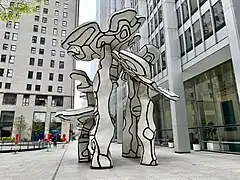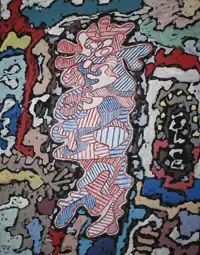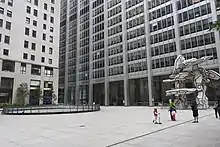Group of Four Trees (Jean Dubuffet)
Group of Four Trees is an abstract outdoor sculpture completed in 1972 by the French 20th-century artist Jean Dubuffet. Originally commissioned by the American banker and philanthropist David Rockefeller, the work measures 43 feet and is installed in the public plaza of 28 Liberty Street (formerly One Chase Manhattan Bank Plaza) between Nassau Street and Pine Street in Financial District, Manhattan.[1]
| Group of Four Trees | |
|---|---|
 Jean Dubuffet's Group of Four Trees pictured in April 2023 | |
| Artist | Jean Dubuffet |
| Completion date | 1972 |
| Movement | Art brut |
| Subject | Abstract |
| Dimensions | 13 m (43 ft) |
| Location | New York |
| 40°42′27″N 74°00′32″W | |
Dubuffet, a leading figure in the Art Brut movement, considered Group of Four Trees as part of his Hourloupe series. The series, originating from ballpoint pen doodles in 1962, features flat, interlocking shapes and striated coloring in red, white, and blue against black backgrounds. At the time of installation, Group of Four Trees was the largest outdoor sculpture in New York City and was said to have dramatized "the increasing environmental interdependence between architecture and outside sculpture" in the 1970s.[2]
Historical context
Following the completion of One Chase Manhattan Plaza in 1960, the building's arts committee, which was headed by David Rockefeller, was tasked with finding and commissioning public sculptures that could be installed in the building's 2.5-acre plaza.[2] In 1964, a fountain installation by the Japanese-American artist Isamu Noguchi titled Sunken Garden was placed below the surface of the plaza while remaining visible from above.[3]
The French artist Jean Dubuffet was chosen as the second artist to participate in the project in 1970.[2] His work was associated with the Art brut movement in France and Dubuffet was known for the inventive use of unconventional artistic materials. He coined the term Art brut or "raw art" to describe "works that drew on the aesthetic of works by prisoners, children, and people with mental illness".[4] Such an approach stood in contrast to "high modernism, which prized itself on rigid notions of artistic genius".[4] Many of Dubuffet's works employ oil paint with an impasto texture, enriched by materials such as sand, tar, and straw, resulting in a uniquely textured surface.[5] By the late 1960s, he had shifted toward three-dimensional works using unorthodox mediums, including chemical substances such as polystyrene, polyester and epoxy.[6]
Commission

On 23 November 1970, David Rockefeller announced that Dubuffet had been tasked with creating a large-scale abstract sculpture titled Group of Four Trees and that the work would be Rockefeller's "gift to the bank and the downtown community".[2] The sculpture was made with 25 tons of aluminum and steel, fiberglass, and plastic resin covered with polyurethane paint and composed of "crude interlocking forms and thick coloring-book lines".[8]
Dubuffet described Group of Four Trees as part of his Hourloupe works, that is "some wonderful or grotesque object (...) something rumbling and threatening with tragic overtones".[8][9] The artist began the Hourloupe series in the early 1960s, characterized by flat, interlocking shapes and striated coloring, typically red, white, and blue, often set against a black background.[10] Dubuffet's inspiration for this style stemmed from ballpoint pen doodles he made during a phone conversation in July 1962.[10]
The artist did not classify Group of Four Trees as a sculpture but rather as "unleashed graphisms" or "drawings which extend and expand in space".[9] Dubuffet delivered a speech on 24 October 1972 on the occasion of the sculpture's installation where he discussed ways in which Group of Four Trees fit into his artistic practice during that time.[11] He said: "I could not have hoped for a place better suited to this monument (...) Indeed, this plaza, and the prodigious buildings which rise above and surrounding it, are the dramatic illustration of an extraordinary celebration of reason, logic, and calculations".[12]
Reception

The sculpture is said to provide "striking contrast to the tall and sleek buildings of corporate New York".[9] When a maquette of the sculpture was presented during a press conference, critic David L. Shirley of The New York Times said that the work looked "like a weird cross‐pollination of mammoth Alice‐in‐Wonderland mushrooms and a jig saw puzzle for giants".[2]
Writing about Dubuffet's work in 1983, art historian Harold Rosenberg said that it "ranks among his best".[12] Rosenberg praised the scale of the sculpture made of "irregular horizontal shapes that appear to float above deliberately clumsy bases—the 'trunks' of the trees" and its ability to maintain a balanced relationship between human presence and the surrounding skyscrapers. He further described the colors and texture surfaces as "physically relaxing" and suggesting that it will "serve as a shady arbor" during summertime.[12]
See also
References
- Rosenfeld, Lucy D. (2013). Art on Sight: The Best Art Walks In and Near New York City. Marina Harrison. Woodstock, Vermont: Countryman Press. p. 93. ISBN 978-0-88150-996-0.
- Shirey, David L. (1970-11-24). "Dubuffet Is Doing 40‐Foot Sculpture for Chase Plaza". The New York Times. ISSN 0362-4331. Archived from the original on 2018-08-08. Retrieved 2023-04-15.
- Kirsch, Matthew. "Ten Architects". The Noguchi Museum. Archived from the original on 2022-12-07. Retrieved 2023-04-15.
- Selvin, Claire (2020-09-03). "Jean Dubuffet's Limitless Imagination: Why One of the Artist's Ambitious Environments Is Being Newly Fabricated". ARTnews.com. Archived from the original on 2022-11-28. Retrieved 2023-04-16.
- Five Europeans: Bacon, Balthus, Dubuffet, Giacometti. Introduction by John Coplans. Irvine, California: University of California, Irvine Art Gallery. 1966.
{{cite book}}: CS1 maint: others (link) - Cardinal, Roger (2003). "Jean Dubuffet". Grove Art Online. Oxford University Press. doi:10.1093/gao/9781884446054.article.T023832. Retrieved 2023-04-16.
- Franzke, Andreas (1981). Dubuffet. New York: Harry N. Abrams. p. 164. ISBN 0-8109-0815-8.
- Halle, Howard (2018-11-20). "Everyday sculptures you pass by in NYC explained". Time Out New York. Archived from the original on 2023-04-17. Retrieved 2023-04-15.
- Harrison, Marina; Rosenfeld, Lucy D. (2004). Artwalks in New York: Delightful Discoveries of Public Art and Gardens in Manhattan, Brooklyn, the Bronx, Queens, and Staten Island. New York: New York University Press. p. 6. ISBN 1-4175-8823-3.
- Alley, Ronald (1981). Catalogue of the Tate Gallery's Collection of Modern Art other than Works by British Artists. London: Tate Gallery and Sotheby Parke-Bernet. p. 184. ISBN 0-85667-102-9.
- Dubuffet, Jean (2011). "Speech, New York, October 24, 1972". Jean Dubuffet: Writings on Sculpture. Düsseldorf: Richter Verlag. p. 98.
- Rosenberg, Harold (1983). "Dubuffet: Shockers and Fairy Tales". Art on the Edge: Creators and Situations. Chicago: University of Chicago Press. pp. 87–89. ISBN 0-226-72674-6.